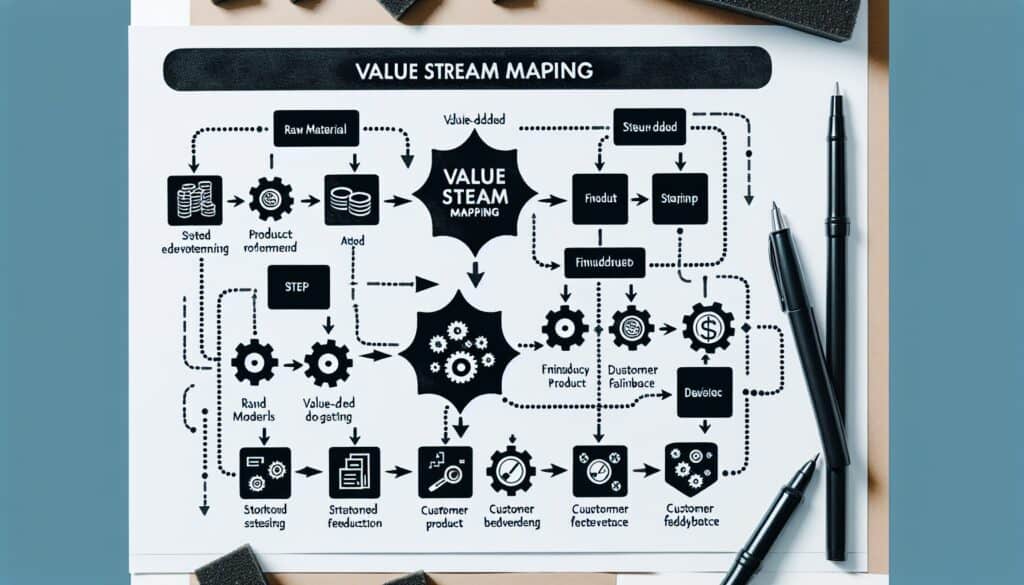A Lean management tool used to visualize, analyze, and improve all the steps (both value-added and non-value-added) in a product or service delivery process, from raw material to the customer.
- Méthodologies : Économie, Lean Sigma, Fabrication, Résolution de problèmes, Qualité
Value Stream Mapping (VSM)

Value Stream Mapping (VSM)
- Amélioration continue, Production allégée, Production allégée, Amélioration des processus, Cartographie des processus, Analyse de la valeur, Ingénierie de la valeur (EV), Cartographie de la chaîne de valeur, Stratégies d'élimination des déchets
Objectif :
Comment il est utilisé :
- Involves creating a "current state map" showing the flow of material and information, identifying waste and bottlenecks. Then, a "future state map" is designed with improvements to reduce waste and improve flow, followed by an implementation plan.
Avantages
- Provides a holistic view of the entire process flow; Helps identify and eliminate waste (muda) and improve lead time; Facilitates system-level thinking rather than isolated process optimization; Visual tool that enhances communication.
Inconvénients
- Can be complex and time-consuming to create, especially for large value streams; Requires active participation from a cross-functional team; Future state realization requires significant effort and change management.
Catégories :
- Lean Sigma, Fabrication, Résolution de problèmes, Gestion de projet, Qualité
Idéal pour :
- Identifying and eliminating waste in a process to improve flow, reduce lead time, and increase value delivered to the customer.
Value Stream Mapping (VSM) serves as a powerful methodology across various sectors such as manufacturing, healthcare, and software development, where understanding the flow of value is paramount. In manufacturing, for example, automotive companies utilize VSM to visualize workshop processes, enabling them to pinpoint inefficiencies between assembly lines and material handling systems. In healthcare, hospitals apply VSM to optimize patient flow, thereby enhancing service delivery while minimizing waiting times. This methodology is particularly effective in the initial phases of a project where mapping current operations can yield significant improvements. Participants typically include cross-functional teams comprising engineers, operators, and stakeholders who contribute diverse perspectives on process challenges and opportunities. Conducting regular workshops or Kaizen events can invigorate this practice, encouraging continuous updates to both current and future state maps as processes evolve. A hallmark of VSM is its visual nature, which not only simplifies complex workflows but also promotes enhanced communication among team members, fostering a shared understanding of goals and metrics that drive performance improvements. Exporting VSM findings into action plans sets a structured path for change, leading to measurable reductions in cycle times and increases in customer satisfaction. The collaborative approach reinforces a culture of continuous improvement, supporting organizations in their pursuit of principes de l'allégement while establishing a framework for sustainable operational excellence.
Principales étapes de cette méthodologie
- Create a current state map illustrating material and information flow.
- Identify areas of waste and bottlenecks within the current state map.
- Analyze identified wastes and prioritize them based on impact.
- Design a future state map featuring improvements to enhance flow.
- Develop an implementation plan detailing actions to achieve the future state.
- Establish metrics to measure improvements post-implementation.
- Communicate the future state and implementation plan to stakeholders.
- Execute the implementation plan and monitor progress regularly.
Conseils de pro
- Incorporate feedback loops into the VSM process to enable continuous improvement and real-time adjustments.
- Utilize data-driven metrics alongside qualitative observations to inform the current state analysis for a more robust mapping.
- Engage cross-functional teams during both mapping phases to ensure diverse perspectives and enhance collaborative problem-solving.
Lire et comparer plusieurs méthodologies, nous recommandons le
> Référentiel méthodologique étendu <
ainsi que plus de 400 autres méthodologies.
Vos commentaires sur cette méthodologie ou des informations supplémentaires sont les bienvenus sur le site web de la Commission européenne. section des commentaires ci-dessous ↓ , ainsi que toute idée ou lien en rapport avec l'ingénierie.
Contexte historique
1949
1950
1950
1960
1960
1960
1960
1940
1950
1950
1958
1960
1960
1960
1960
(si la date est inconnue ou n'est pas pertinente, par exemple "mécanique des fluides", une estimation arrondie de son émergence notable est fournie)















Articles Similaires
Calculateur de METS en calories
Méta-analyse
Cartographie des messages
Diagrammes du modèle mental
Forces de poussée et de traction maximales acceptables
Planification des besoins en matériaux (MRP)